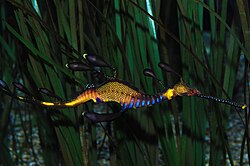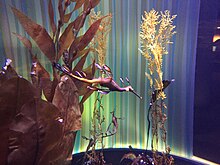Common seadragon
From Wikipedia, the free encyclopedia
Common seadragon or
weedy seadragon (
Phyllopteryx taeniolatus) is a
marine fish related to the
seahorse.
Adult common seadragons are a reddish colour, with yellow and purple
markings; they have small leaf-like appendages that resemble kelp fronds
providing
camouflage and a number of short spines for protection.
[2][3] Males have narrower bodies and are darker than females.
[3] Seadragons have a long dorsal fin along the back and small pectoral fins on either side of the neck, which provide balance.
[4] Common seadragons can reach 45 cm (18 in) in length.
The common seadragon is the marine emblem of the Australian State of
Victoria.
[5]
Range
The common seadragon is
endemic to
Australian waters of the Eastern
Indian Ocean and the South Western
Pacific Ocean. It can be found approximately between
Port Stephens (New South Wales) and
Geraldton, Western Australia, as well as
Tasmania.
[6]
Common Seadragon,
Phyllopteryx taeniolatus, from the
Sketchbook of fishes by
William Buelow Gould, 1832
Habitat
The
common seadragon inhabits coastal waters down to at least 50 m (160 ft)
deep. It is associated with rocky reefs, seaweed beds, seagrass meadows
and structures colonised by seaweed.
[7]
Biology
These
fish are slow-moving and rely on their camouflage as protection against
predation; they drift in the water and with the leaf-like appendages
resemble the swaying seaweed of their habitat.
[3] They lack a prehensile tail that enables similar species to clasp and anchor themselves.
Individuals are observed either on their own or in pairs; feeding on tiny
crustaceans and other
zooplankton by sucking prey into their toothless mouths.
[3]
Like seahorses, seadragon males are the sex that cares for the
developing eggs. Females lay around 120 eggs onto the brood patch
located on the underside of the males' tail.
[3] The eggs are fertilised and carried by the male for around a month before the hatchlings emerge.
[3]
Seadragons, seahorses and
pipefish
are among the few known species where the male carries the eggs. The
young are independent at birth, beginning to eat shortly after.
[8] Common seadragons take about 28 months to reach sexual maturity, and may live for up to six years.
[9]
Mating in captivity is relatively rare since researchers have yet to
understand what biological or environmental factors trigger them to
reproduce. The survival rate for young common seadragons is low in the
wild, but it is about 60% in captivity.
[10]
The
Aquarium of the Pacific in Long Beach, California and the
Tennessee Aquarium in Chattanooga, Tennessee
[11] in the USA, and the
Melbourne Aquarium in Melbourne, Australia
[12]
are among the few facilities in the world to have successfully bred
common seadragons in captivity, though others occasionally report egg
laying.
[13] In March 2012 the
Georgia Aquarium in Atlanta, USA, announced a successful breeding event of common seadragons.
[14] As of July 2012, the
Monterey Bay Aquarium has also successfully bred and hatched out baby common seadragons on exhibit.
[15]
Threats
The common seadragon is classified as
Least Concern (LC) on the
IUCN Red List 2006.
[16]
While the common seadragon is a desired species in the international
aquarium trade, the volume of wild-caught individuals is small and
therefore not currently a major threat. Instead, habitat loss and
degradation due to human activities and pollution threaten common
seadragons most.
The loss of suitable seagrass beds, coupled with natural history
traits that make them poor dispersers, put the future of seadragon
populations at risk. This species is not at present a victim of bycatch
or a target of trade in Traditional Chinese Medicine, two activities
which are currently a threat to many related
seahorse and
pipefish populations.
[17][18]
Conservation
It is illegal to take or export these species in most of the states within which they occur.
[3]
A database of seadragon sightings, known as 'Dragon Search' has been
established with support from the Marine and Coastal Community Network
(MCCN), Threatened Species Network (TSN) and the Australian Marine
Conservation Society (AMCS), which encourages divers to report
sightings.
[3]
Monitoring of populations may provide indications of local water
quality and seadragons could also become an important 'flagship' species
for the often-overlooked richness of the unique flora and fauna of
Australia’s south coast.
[3]
Captive breeding programs are in place for the weedy seadragon,
headed up by Sea Life Melbourne Aquarium. The dragon has been difficult
to breed in captivity, though in 2015 research observing the creatures
in the wild and trying to replicate the conditions in captivity had
researchers making changes to the light, water temperature and water
flow proving to be key.
In December 2015 the Melbourne aquarium had eggs hatch and the
aquarium's weedy seadragon population significantly increased, reporting
in March 2016 that 45 fry were still going strong—an outcome which
represents a 95 percent survival rate.
[19]
Related species
The common seadragon is in the subfamily
Syngnathinae, which contains all pipefish. It is most closely related to the other member of its genus, the
ruby seadragon (
Phyllopteryx dewysea), and also the
leafy seadragon (
Phycodurus eques).
Haliichthys taeniophorus, sometimes referred to as the "ribboned seadragon" is not closely related (it does not form a true
monophyletic clade with weedy and leafy seadragons).
[20]
The common seadragon was previously the only member of its genus until the description of the ruby seadragon in 2015.
[21]
Ongoing research
In the November 2006 issue of
National Geographic
magazine, marine biologist Greg Rouse is reported as investigating the
DNA variation of the two seadragon species across their ranges.
References
This article incorporates text from the
ARKive fact-file "Common seadragon" under the
Creative Commons Attribution-ShareAlike 3.0 Unported License and the
GFDL.








No comments:
Post a Comment